Utopia in Progression: On the Social Relevance of the Arts in the 21st Century
| May 28, 2024
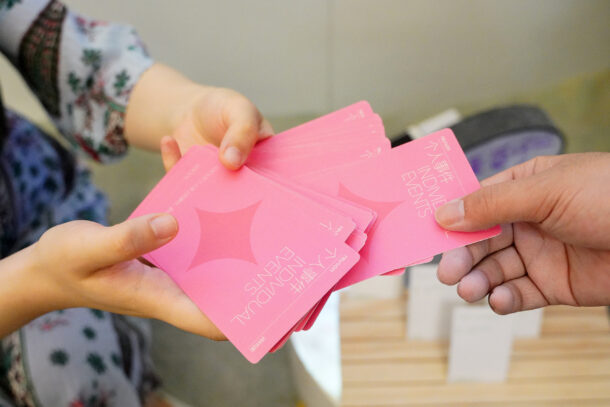
Player draws a personal event and affects their life status
Photographed by Yannan Pan
Utopia in Progression
It was the summer of 2021, just before the demolition of the Dinghaiqiao neighborhood. I sat on the first floor of 252 Dinghaigang Road, where the Dinghaiqiao Mutual-aid Society (DMaS) was located. I was with my collaborators, Yiren Zhao and Mengyang Zhao, and we were preparing to give a farewell lecture before I left the city.
By that time, I had spent five months in Shanghai as an artist-in-residence of DMaS and the 13th Shanghai Biennale. Yiren, Mengyang, and I lived together in this building, working on a project called Liquid Dependencies: What Does a Decentralized, Caring Society Look Like? (referred to as Liquid Dependencies for short). It was a role-playing game for 10 players, where they would build long-term, mutual, caring relationships based on a future welfare system called ReUnion Network. In the game, the players would be assigned characters that they needed to bring to life with their own experiences. For 4 to 5 hours, the players would experience 20 to 30 years of life together and deal with a series of personal and social events. From the first call for beta testing to the public sessions in the Biennale, we gathered around 200 players from different cities, each of them going through 20 to 30 years of in-game lifetime in this hypothetical society. On this last day of my Shanghai residency, we sat together around the dinner table for the last time, waiting to meet the players that we had once encountered in the fictional setting.
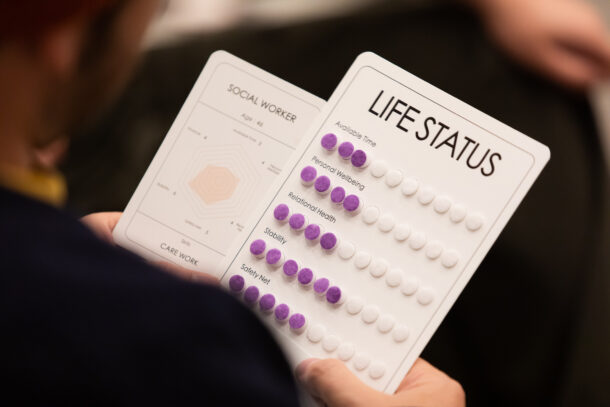
A player is looking at their character card and Life Status Card
Photographed by Tom Doms
The first floor was full that day, with a dozen participants online. Many of them were players in the game. They came to hear the thought process behind the fictional world they co-lived briefly. Many of the players told me how Liquid Dependencies had changed the way they perceived life: some decided to put more effort in building a wider social safety net, following the game’s suggestion; some asked me if there is an intention to realize the social proposal. But there were also two players who told me it was hurtful to experience the game, as they knew this fictional life would never come true in their reality. They did not come to the lecture in the end. As Shanghai migrants for over a decade, they had fully experienced the barriers for them in the city. For them, the brief imagination of a warm, supportive, and non-alienated society was deeply painful, so much so they would rather never have encountered one. “Your game is too utopian, and it hurts,” they told me. As for those who did attend the lecture, they more or less wondered how this “utopia” could come to realization, with a fair dose of skepticism.
“Liquid Dependencies is not a utopia, and its utopian feeling comes from the fact that it never aims to be one.” As if a response to a question never asked, I opened my lecture as such. “In fact,” I followed, “if a designer started their project with the pursuit of a utopia, they would most likely end up with a dystopian idea.” The audience looked quite hesitant, if not confused. As if I was denying the beautiful picture that we offered to them.
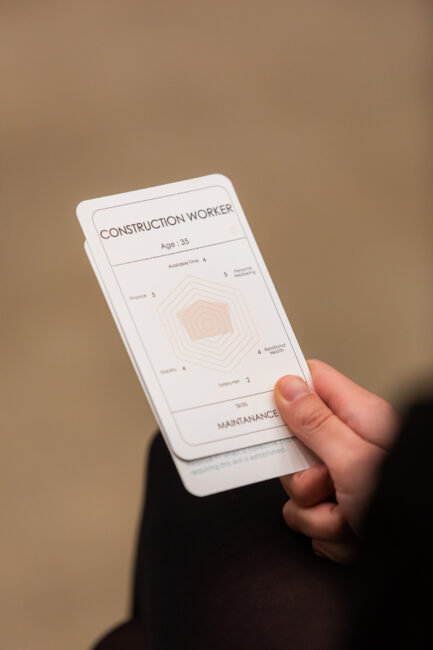
A player receives their in-game character, stating their occupation, age,
skills and life status as Available Time, Personal Wellbeing,
Relational Health, Stability and Finance
Photographed by Tom Doms
For a long time, I wondered why these players would consider the game a utopia, given that many of them experienced dramatic ups and downs in their fictional journey. Critical illness, unemployment, family disputes, unstable housing—people often encounter authentic disasters that can happen to any normal person. We deliberately design plots that feel highly plausible in real life, so that they can believe in the attainability of the fictional side of the experience: a society that supports mutual aid commitments and new kinships[1] both institutionally and financially. As it turns out, people who find our conceptual film too idealistic, often are the same ones who ask if we plan to make it happen at the end of their game sessions, even if they may go through a series of devastating events in the game.
About two years later, one of our assistants Yubin provided an answer: it felt like a utopia because it embraces all the unpleasant, even ugly sides of reality and humanity, yet still finds a constructive way to bring people together, and care for each other. She commented on the other project we are working on, the Alchemy of Commons, a project that researches why intentional communities are so difficult to maintain and what kinds of support they would need in order to realize their intentions. In this article, I will share the histories and the thinking that led me to this direction of making, or not making, utopias.
(dys) Utopian Production in the 21st Century
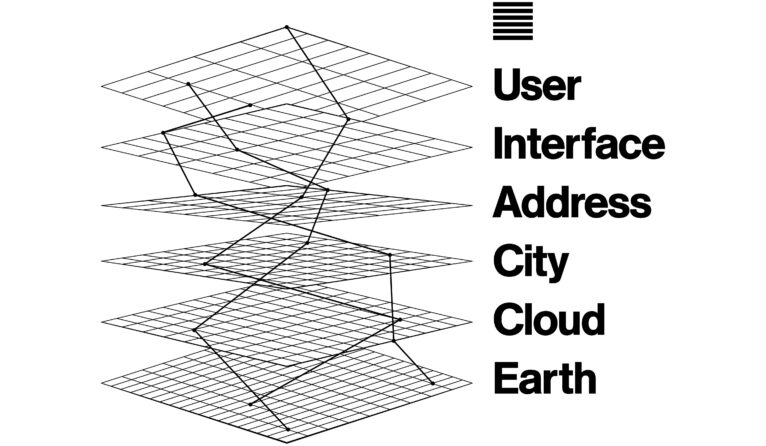
Metahaven, Diagram of The Stack by Benjamin Bratton, 2016
Between the 2000s and 2010s, a new trend emerged in critical, socially-engaged art & design practice that looks into geopolitics and global infrastructure as “designable objects”. This approach was popularized through works such as Uncorporate Identity by Dutch art & design duo Metahaven, and The Stack by Benjamin Bratton, an American design theorist and philosopher, who presents the book as “a design brief of planetary computation”. Simultaneously, there was a resurgence of cyberpunk in mainstream cultural production, fueled by the ubiquity of the internet, smartphone, and surveillance capitalism. This was particularly evident in the British TV series Black Mirror. These two movements converged, leading to a proliferation of planetary dystopian narratives in art and design, particularly within the realm of speculative art, design fiction and world-building practices. At this point, especially design practices liberated themselves from the obligation to provide solutions. Instead, the focus shifted to raising questions, especially at a time when the benefits of neoliberal globalization appeared to be flourishing for everyone.
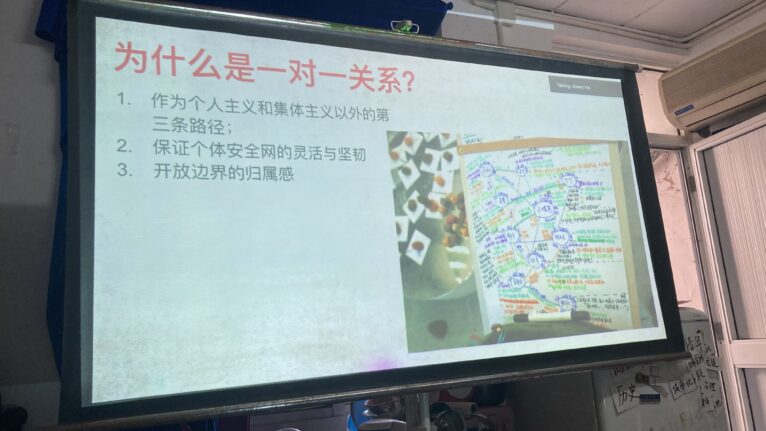
Keynote slide from the author’s farewell lecture at DMaS. On the slide: “Why one-on-one relationship?
Photographed by Yiren Zhao
Meanwhile, there is a growing movement of processual, situated and communal socially-engaged art & design practices emerging on the outskirts of the cultural industries. In contrast to the dominant Western-led dystopian speculative practices that emphasize tangible outcomes for spectatorship, these alternative practices are often localized, participatory and ingrained in everyday life. They prioritize alternative economies, alternative modes of organization, experimental labor distribution, and the advocacy of social justice. These practices predominantly thrive in the Majority World, especially in regions with limited or no art funding. This particular subset of art practices reached its current peak during documenta fifteen, annotating the continuously turbulent polycrisis around the globe.
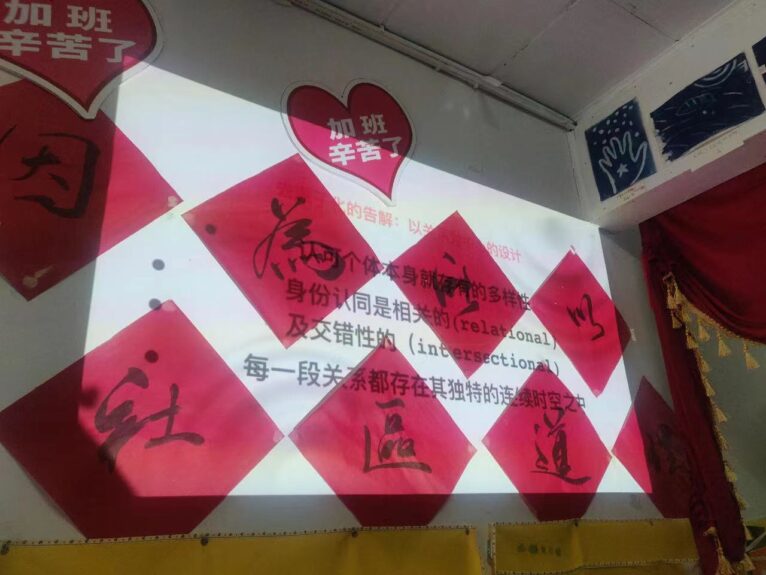
Keynote slide from the author’s first lecture at DMaS, entitled “Resolution of Atomization: Relationship-centered Design”
Photographed by Yiren Zhao
Both of these ethos are two sides of the same coin. They both react to a compromised version of globalization that has been delivered to us, albeit through different approaches and subject matters. Dystopian productions, ranging from artwork and speculative design, to TV series and startup products, often intend to act as satires or cautionary tales. However, they often unintentionally inspire the powerful, or contribute to the consumerist fascination with apocalypse since the 1990s. Neither scenario effectively fulfills the intended purpose of being a critique, as envisioned by most practitioners. Instead, the increasingly radical cringeworthy near-future productions continue to desensitize society to the potential risks that lie ahead. Moreover, this type of production is often emphasized in depicting the inevitability of doomsday scenarios rather than exploring alternatives, or offering different perspectives to understand the dystopia itself. What is even more concerning is that this kind of production becomes a reflexive critical practice in the cultural field, the realm of arts, which should serve as a space for imagination becomes saturated with visions of doomsdays. It is as if these practitioners collectively declared Mark Fisher’s statement is permanently true: it is easier to imagine an end to the world than an end to capitalism.[3]
What Makes Socially-engaged Art so Uncomfortable in the Arts
Things might look brighter on the other side, in which people attempt to organize actions and communities to practice the alternatives. From China to Indonesia, from Brazil to South Africa, artists from the Majority World feel a sense of urgency and necessity to come together and explore different ways to work and live. When comparing these practices with similar ones in the Global North, it becomes apparent that the Majority World offers more nuanced and interesting practices in order to engage with far more complex, sometimes extreme and unpredictable, socio-economic and cultural conditions.
The Global North, especially in Western Europe, benefits from better funding and industrial conditions, at the same time, their practices are often directly influenced by these conditions. As a result, collective practices in the Global North tend to be performative and short-term in nature, as fundings are typically allocated to time-bound projects rather than sustainable long-term practices, reflecting the fact that the art economy at large is centered around objects, exhibitions, and public events. Given that communal and socially-engaged art is not naturally good for making these deliverables, it is difficult for these practices to get funded. But the very presence of the funding system and the flourishing industrial environment are enough to exhaust these communities’ energy to look for viable income sources within these institutionalized spaces. And by doing so, the local practices often feel the necessity to make their work suitable in the eyes of funders.
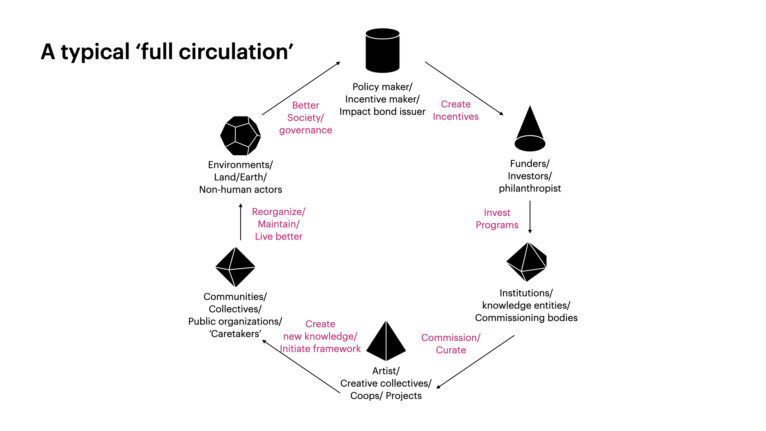
A flowchart represents the European Funding Model
Courtesy of the author
Practices in the Majority World, however, have a better chance to go beyond showbiz logic and become more sustainable. Given that there were not many functioning funding systems around, collective practices are a necessity and a need for artists to pull resources and support each other. Consequently, collective practices in these places must meet needs in the practitioners’ daily lives other than the financial (since there is little possibility for it). One can see the operating baseline is already different from the North: needs for everyday life, instead of an event for a period of exposure.
What does it have to do with utopia? As Shannon Brincat, an Australian scholar of International Relations, pointed out “[t]he dominant misconception of utopia as a perfect, static system has long been redundant within Utopian Studies but unfortunately persists in common parlance.”[4] Instead of being a static blueprint that is doomed to be a lost cause, many scholars in Utopia Studies have suggested that utopia is (should be) a desire[5], a transgressive vision[6] of different and better ways of being, or proving ground for “utopian activity”[7]. Socially-engaged art, whether it is from the North or the South, aligns with this thinking. To exercise a vision, or a desire for an alternative society, they stress the necessity of open-endedness and processual nature to ensure the spaces for “utopian activity” for transgressing existing systems, even though this necessity may compromise their chances to receive funding.
However, in reality, we witness different fallouts of intentional communities, especially within socially-engaged art. Many of these “failures” follow similar scripts: disputes over payment and labor distribution, unequal relationships among members, disagreements over ideology and practices, and more. These troubles are not unique to the arts but are commonplace in any collaborative endeavor. So why does it feel especially disheartening when it happens within the art world?
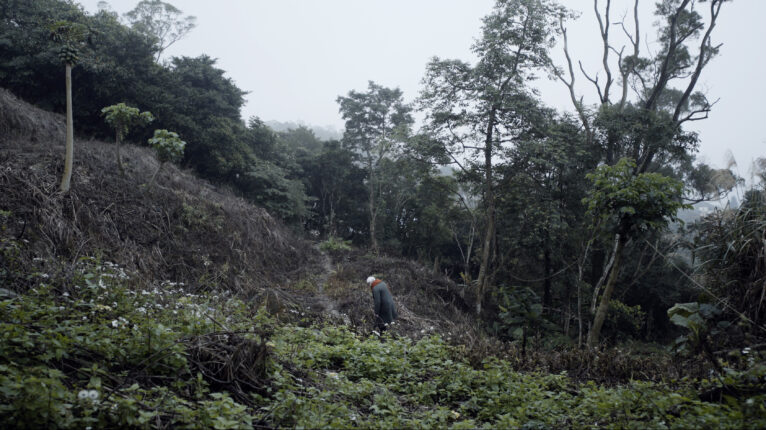
Still from the concept film for ReUnion Network
Courtesy of the author
Our research indicates that disputes within art communities are often heightened by the pressure of spectatorship, along with the constraints of project budgets and tight deadlines. When a community aims to present a utopian practice for exhibition, they feel a heightened need to portray flawless cohesion during that specific period of time. However, the production of an exhibition itself is often the most challenging and conflict-inducing moment. Community members may easily feel ignored and instrumentalized when the issue cannot be addressed due to the stress of the presentation. Furthermore, those who raise concerns may be accused of being self-centered and narrow-minded in the midst of a “significant moment” for the community. The spectatorship leads to a shifting community focus from the process of “utopian activity” to representing static utopian blueprints. Unfortunately, this kind of context shift, or cognitive twist is extremely subtle and hard to detect as the art economy generally does not provide functioning spaces that can be excused from the obligation to be seen.
I once ran into an argument with an artist who suggested a radically horizontal institution should run by equal pay and equal say for all staff. He raised an example that, a cleaning staff has a unique perspective to understand of the institution so they should be able to contribute to the curatorial program and how the organization should run. “I agree with you on the first part,” I responded, “but do they want to do the latter? If they feel obligated to participate, either because you made it part of their work, i.e. their income is at hinged, or that they sense your need to perform a radically horizontal organization and they feel compelled to perform with you? And if they do, have you done enough work to prepare them, and support them, until they gain full experience and confidence to assert their contribution?” What I did not spill out was: would you be too anxious to remain in the leader position before they can work independently, because your de facto leadership would look bad on your utopian image?
“You are complicating things with these small details,” the artist responded with a hint of annoyance. “I am not,” I object. “These are serious issues to think through because I want it to happen!” This was not the first time I found myself in such a conversation. It seems that many artists and designers are overly proud of their radical imagination, perceiving any questions about practicality and the nitty-gritty as an attack on artistic integrity, or a lack of artistic quality. The most frustrating part is many self-proclaimed progressives failed to take these questions seriously. They may discuss it with a serious attitude but hardly invest comparable energy into identifying real problems and finding plausible solutions. Practical questions, difficult organizations, and unpleasant conflicts then are treated as if they are stains on a utopian image, or worse, a personal affront. Instead of viewing them as integral parts of transgressive processes in the existing system, they are made unseen.
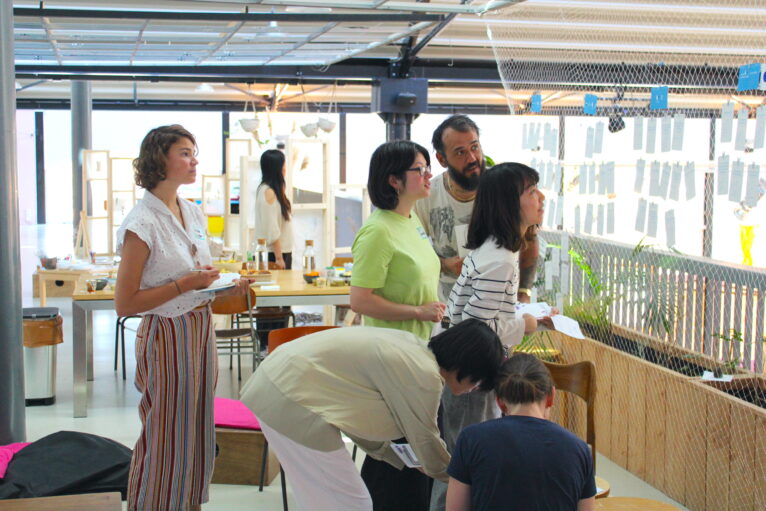
Players are checking the Community Market for available services and products
Photographed by Samuel White Evans
Indeed, to live in the flurry of the spectacle-driven art world, the artists who can thrive are often those who can maintain relentless enthusiasm for creating radical visions without being bogged down by the details of executions and micro-politics that come with them. This approach allows them to produce enough artwork to meet the demands of the market. Ironically, this way of engaging with radical imagination has become so widespread that these artists can hardly discern whether they are truly creating spaces for “utopian activity”, or simply presenting careless blueprints.
I find this is the deepest kind of dystopia, when an entire industry that is supposed to offer a comparatively open space to imagine the alternative, and yet is structured to look away from the practical steps to get there. Whether it is the dreadful abundance of insightless dystopian productions or the social practices that are distracted by the face value of utopia, they are nothing more than a symptom of a deeply cynical industry.
The Problem of Maintenance
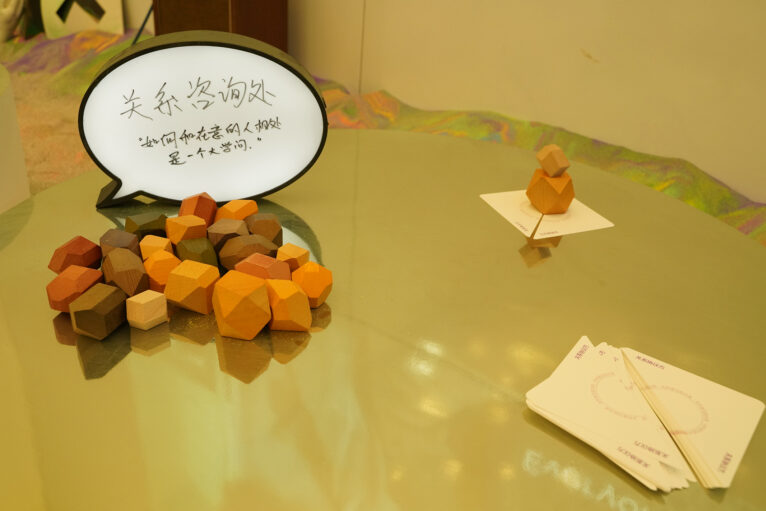
Relationship Consulate from the installation/playground of Liquid Dependencies at the 13th Shanghai Biennale
Photographed by Yannan Pan
Now, what is left after bashing about the world I inhabit? It would be too ironic of me to rant about the structural problems and then leave the room. I did not. Coming from a design background, and I have had an uneasy relationship with the industry. The arts have provided me a shelter to think about alternative practices in design. Despite all the problems I lash out, the arts continue to be one of the few spaces in society that allow individuals to contemplate and delve into vague ideas even when there is no promising direction yet. You may not get financial support, but you can have comrades, in one way or another. That is why, looking into the frustrations and unfulfilled promises and finding ways to work through them are my ways of loving this world.
To be fair, there are indeed many artists creating useful art[8] with a wide social impact. However, these works somehow hardly continue when the initial hype dies down. For example, the Dutch artist Femke Herregraven created Taxodus[9], a global tax avoidance game that received significant media attention and was widely used in public education. However, as Herrgraven’s artistic career soared, her energy was directed elsewhere. The work remained in its initial outlook despite continuous requests for updates and collaboration.
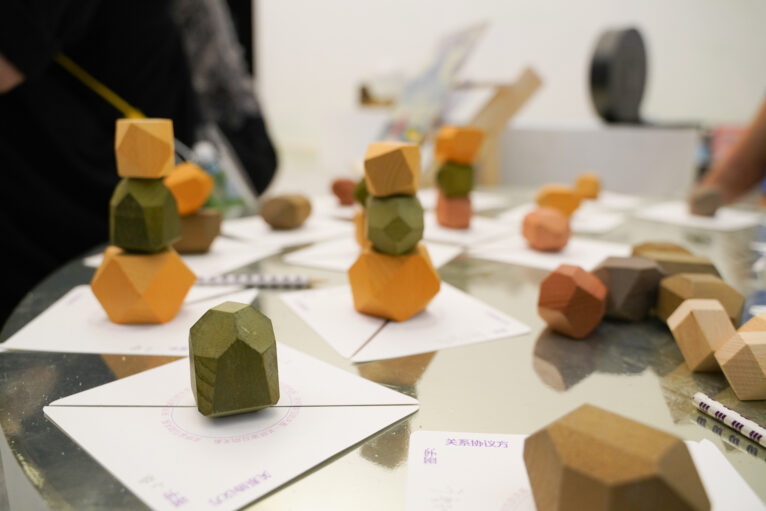
Relationship agreement and the status of the relationship, represented by the relationship stones. The number of stones represents the relationship stages, their color and placement are decided by the players
Photographed by Yannan Pan
Understanding everyone’s energy is finite and has to be prioritized for their best interest, I approached Herrgraven with a speculative question: would it be a desirable situation if her work could be taken care of by people who need the work? And if it was, how would she like to be involved if the caretaker may need to update, or even make changes to maintain the work’s social relevance? She paused for a thought and responded that she would be really happy if there were people to maintain the work but she would like to have a say if they want to make some changes.
Her response was the starting point of my collaboration with Binna Choi, a South Korean curator and former director of Casco Art Institute: Working for the Commons. For two years, we have chased after artists whose work has the potential to extend beyond art institutions. Topic-wise, the works range from land ownership, housing issues, care labor to immigrant rights. Their methodologies include working with local residents, process-driven, participatory organization and collective authorship. Artists come from different parts of Europe, North America and Asia, with different cultural backgrounds, gender and racial experience. The idea is to work with these artists collectively to shape a new economic system for maintaining art and make alliances with actors outside of the arts. Despite the wide diversity of projects and artist backgrounds, nearly all of the artists responded with hesitant confirmation of the idea and then kept postponing the discussions until the energy fizzled out.

Relationship Consulate from Liquid Dependencies at the art space Framer Framed in Amsterdam
Photographed by Samuel White Evans
I have elaborated on how the spectacle-driven art world promotes the type of artists who enjoy producing one new work after another, rather than those who stay in and dive deep into one socially impactful work. However, the thirst for constant new production in the arts generates a chain reaction that affects the artist’s mindset. Artists depend on the accumulation of reputation from their projects and portfolios, making it a substantial risk if they were to delegate the maintenance of their work. Not to mention the potential for maintaining parties to exercise the right to make changes to the artwork and potentially gain ownership or authorship. While this maintenance-as-ownership model[10] has sparked enthusiastic discussions among artists and creative institutional practitioners, in practice, it is in the favor of the artist’s career to keep their work as a perfect corpse. An artwork may not be alive per se, but it means the artist can have full control over its presentation. And incidentally, they can have a tad more control over the value of the work, as well as their precarious life of being an artist.
The Value-making Machine for the Arts
Looking back, all of these frustrations have played a significant role in shaping a realistic design brief for a new art economy. There is no meaningful design brief without a clear understanding of the practical history behind the failures and setbacks. If the particularity of the art economy has shaped the artist’s ways of working and engaging with society, and if we were to create a new kind of economy to incentivize artists to work otherwise, what kinds of instruments are out there that we can learn from? Besides exploring trust funds and the relevant web3 technologies, I also have delved into corporate equity, options, futures, insurance, Social Impact Bonds, and so on. So that I can gain insight into the “social affordance” of these public and private financial instruments. and Even though these instruments are largely created for capitalist interest, there is not enough study about their social affordances. Not to mention how these affordances can work otherwise in a different social system.
This research eventually led to what I called as European Funding Model: a typical European funding model for the arts usually has six actors[11] involved: policymakers, funders, institutions, artists, communities and non-human assemblies. The normative process of this model goes like this: policymakers or incentive makers, who usually pick up global and local ethos and create instruments to incentivize changes in society. Investors, funders and philanthropists pick up the incentives to make investments, through open calls, recommendations, or other structural agreements. Institutions or commissioning bodies receive the grant and find suitable artists to commission based on the grant guidelines. The commissioned artists then will create a work that can make an impact on the target audience. Ideally, the impacted audience will continue their lives with a changed mindset and behaviors, and eventually make chain reactions to the non-human assemblies.
While it all sounds perfect, like the flowchart presents, especially for technocratic governments like the European[12] ones, in practice, there are several problems[13] to fulfill the circuit. First of all, in the context that most of the European governments made drastic cuts in funding for art and culture in the last decade, most of the funding guidelines began to measure impact through exposure and consumption. This shift creates an even heavier reliance on attentional economy in the arts, and leads to many problems I mentioned. Secondly, there is structurally little incentive for artists to really connect to communities. So the transaction at the bottom left of the flowchart is hardly working. Within the current logic of the art economy, connecting to non-art audiences and communities is usually perceived as a bonus, as good intent, or even as good content. Just not a necessity.
The art world’s value production has four channels: institutional value, which is nodded by curators, art historians, and institutional leaders; market value, which is determined by auction houses and commercial galleries; symbolic value, in which certain works or artists become an (inter)national symbol and obtain indisputable historical value; and finally, there is what I called as community affect value: a piece of work that profoundly influence the everyday life of a community. For instance, a mural in an African American neighborhood can carry significant meaning for the community but this meaning does not necessarily distill into institutional or market values. While these four channels usually feed into each other, community affect value is always treated like ice on the cake. It is nice to have, but completely fine without it.
The situation is a little bit like the old cult film Cube in 1997. Everyone gets commissioned for a small part of a massive project and works in their small circuit of reasoning, without checking with each other if things ever happen in ways it was assumed. At this point, it is only natural that artists cannot tell the differences between representing a blueprint and making actual transgression of the existing system. After all, even the policymakers that are on the top of the flowchart, are hosting the illusion that simple financial and policy incentives can make artists genuinely make efforts to connect to non-art audiences and communities. Why would a flowchart that is made of assumptions work through anyway?
The Body is the Institution
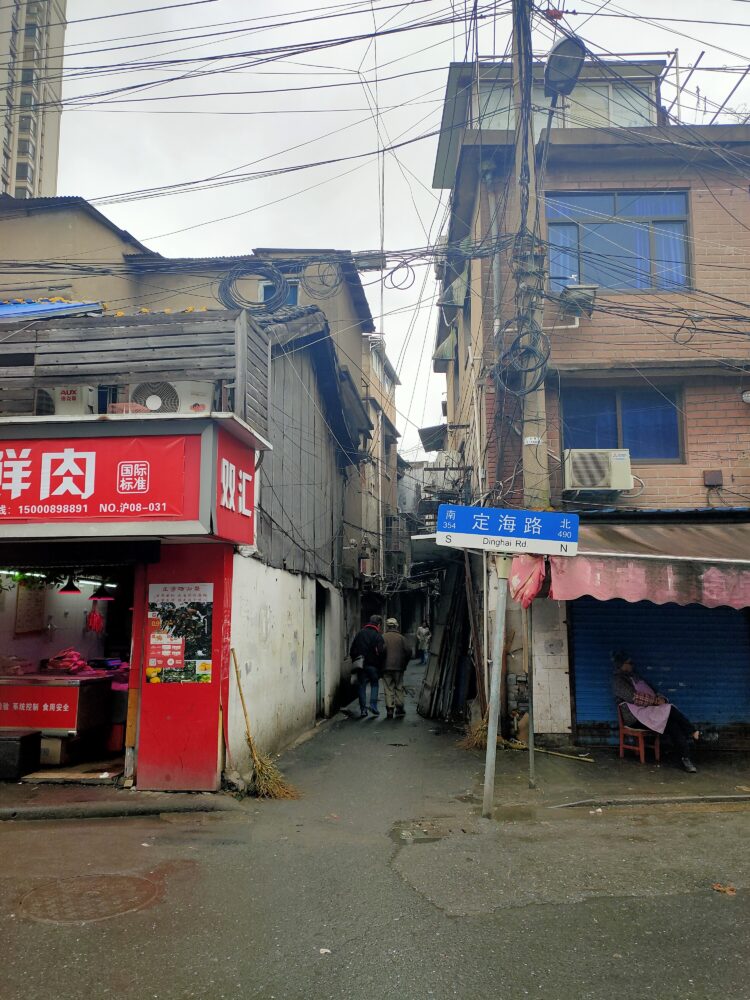
Scene captured around DMaS, 2021
Photographed by Aiwen Yin
I was introduced to DMaS because they seem to be practicing the kind of decentralized caring network that my project ReUnion Network was speculating on. ReUnion Network proposes a welfare system for mutual-aid relationships and new kinships. The system organizes itself through interpersonal, long-term, and caring relationships, instead of individuals, family units or companies. It proposes the third option between individualism and collectivism. Although I developed a completely different approach, its philosophy behind connects to DMaS’ almost instantly.
DMaS is a special collective. Founded by Chen Yun, it was more like a typical artist-led initiative[14] between 2014–2017, that produced a lot of public-facing events, hosting discussions and offering community services to local residents. Inside the initiative, the core team was only Chen Yun and the resident-participant Yiren. In 2018, Yun left the project due to personal reasons, and Yiren decided to continue the work by transforming the initiative into a self-organized community known as the Co-op Plan (Gongzhijihua). This new stage involved a group of a dozen of members to share the rent for the building. The majority of the members were young graduates who frequently participated in previous DMaS events. During this stage, DMaS activities became member-driven and tailored to individual interests, personal circumstances and situated collective reflections. This changing trajectory allowed the collective to obtain an ambiguous position: it can be perceived as an artist collective, but it can also be the community themselves, occupying two positions in the “funding model” flowchart.
In the intersection of these two roles, the members experience the pros and cons from both sides. Yiren shared with me that DMaS has garnered significant attention from researchers and reporters since its inception. However, most of these individuals treat DMaS as an object of research, extracting their life experience for their own purpose without reciprocal contributions. They felt that these scholars, artists, designers and journalists came with their preconceived objectives and narratives about DMaS. And no matter what the DMaS members said they will not change their mind. In a way, they felt silenced, even though they were constantly analyzed and paraphrased.
This was also the reason that I was not particularly welcomed when I just landed in DMaS. Although everyone was friendly, I can sense a lingering sense of caution in the air. It was not long before I discovered the reason behind this caution in the “Mutual-aid Society Co-op Development Manual”[15]. On the last page of this small handbook, it stated: DMaS are cautious about being researched by scholars and interviewed by the press. This attitude is consistent with the Mutual’s long-standing position against knowledge harvesting[…] DMaS has no impulse to scale, they speak about themselves to provoke further self-understanding, instead of self-promotion. [16]This revelation explained the strange smell in the air: I was probably under observation to discern if I was the harvesting type.
But this one line also exposes the artist side of DMaS, which unintentionally inherited the habit of representing an image of “dystopia”. When Yiren asked for my thoughts on the manual, I expressed my intrigue with the entire handbook. “Although,” I said, “I feel like the final sentence was a little too much of a statement, instead of action guidelines.” After all, one can only make productive steps on what they want, instead of what they do not want.
Although that line itself came from a perpetually predatory attitude from the art, design and cultural industry towards living communities, the negative description appears more as an attitude or a strong value statement. When it comes to making positive, actionable changes, it is not of much use. Additionally, a predetermined exclusion will also shut down accidental alliances and unexpected potentials. Even though it was not DMaS’s intention either.
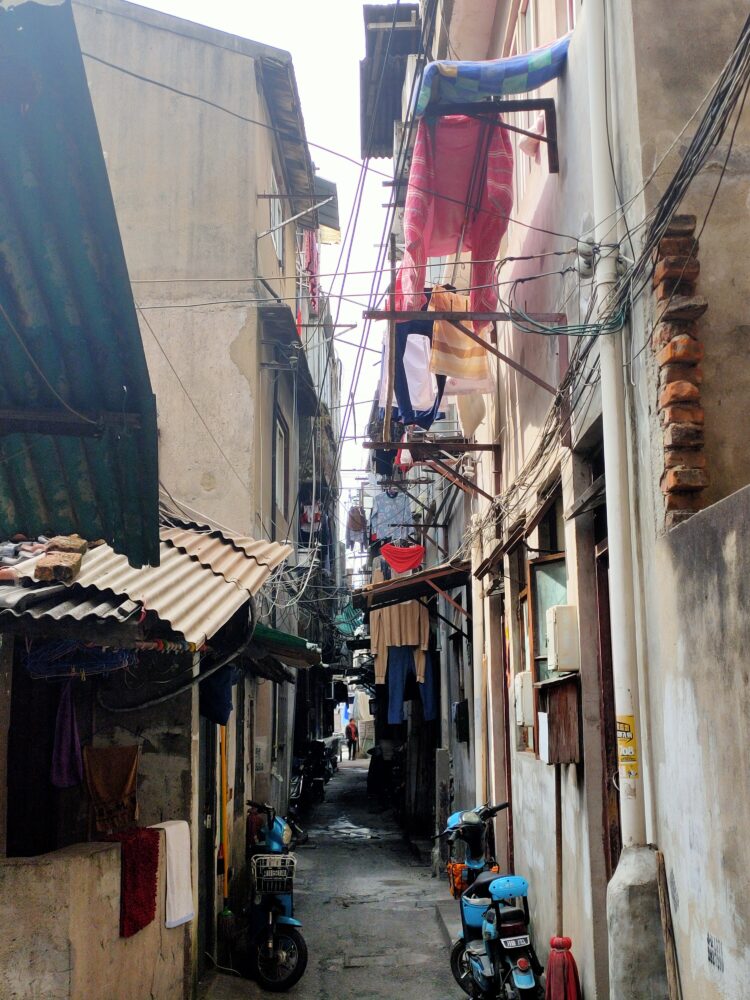
Scene captured around DMaS, 2021
Photographed by Aiwen Yin
Yiren and I met and clicked almost immediately because we share the desire to take actions, and we both believe in taking action relationally and constructively. From the outlook, DMaS’s influence might be exerted mostly through the events they produced, or the publication they made. But in my opinion, the most important—if not groundbreaking—work they do, is the ways they organize themselves and the philosophy behind it.
In the beginning, my impression with DMaS was that they are extremely nuanced and practical in the psychological side of the relational organization. Their commitment to interpersonal care was the cornerstone of the wellbeing of the community, resulting in a consultation-and-negotiation decision-making process. And this idea persisted throughout the four-year journey of the Co-op Plan, which consisted of three overlapping phases based on my analysis.
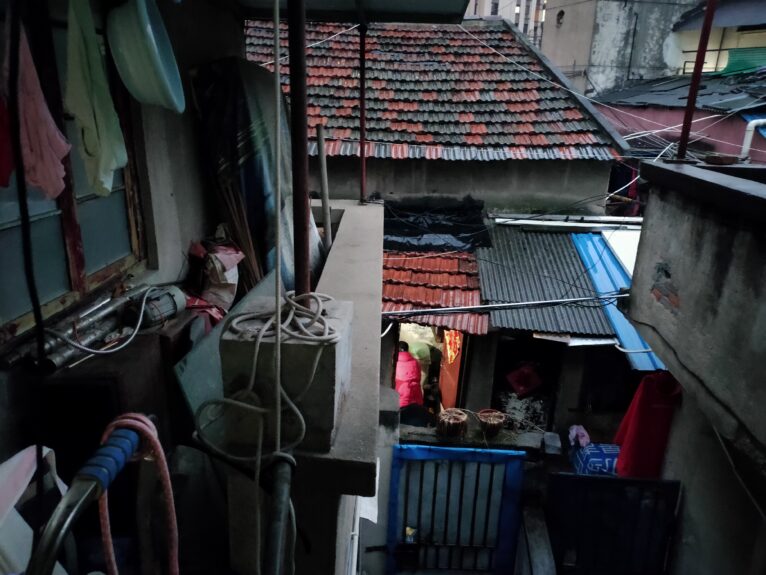
Scene captured around DMaS, 2021
Photographed by Aiwen Yin
At first, when the community members hardly knew each other, they formed small working groups centered around shared interests for self-initiated activities. They called this way of working “mess-around (gao shiqing)”. The Mess-Around phase was a lighthearted way to get to know each other and have a bodily experience of collaborating and organizing together. The bodily experience then helped to provide substance for the members to discuss the code of conduct, the guidelines and the general governance model. By grounding the discussions in tangible shared experience and mindful conversations, the focus shifted away from abstract concepts and ideologies. The organization model collectively crafted through mutual understanding and bodily experience will allow the individuals in the community to feel collectively belong. I call this phase “Maintenance”. With this strong sense of belonging, the community created a safe space for the members to further explore themselves, without fear of jeopardizing the support they receive from the community due to a change of interests or positions. At this point, the community found their metabolic drive and became a genuine mutual-aid network, which is a phase I dubbed as “Mutual-aid” accordingly.
From Mess-Around, Maintenance, to Mutual-aid, DMaS made their “mutual-aid society” as a process of becoming, instead of a point of departure. This progression sets them apart from many intentional communities that begin with a predetermined governance model before the members even know each other. DMaS developed their organization model on a case-by-case basis. Collectively making decisions about all aspects of the organization, from how to share rents to how to maintain a collective safe space, from the means and method to communicate, to the protocols of accepting invitation or collaboration. Whenever similar cases pile up, any member who recognize a pattern could initiate a discussion to put forward certain guidelines. If these guidelines gain consensus from the community as a whole, they would facilitate a smoother decision-making process in the future. However, by no means these guidelines became rigid rules. Any member can question them again if they found new situations challenging the initial reasoning behind the guidelines. At any moment of guideline development, the personal and the collective bodily experience were always present. Thus, the form and shape of the community was always responding to the individual and the collective experience. The governance model evolved as an extension of the co-lived matters within the community, in return supporting the foreseeable future together while avoiding being controlled by rules made in the past. The core of DMaS’ methods point to the essential differences between utopia as a process and utopia as a static blueprint. That is, does the body understand the rules?
Healing as Utopia
In the Alchemy of Commons, the new research I am conducting with Yiren, we dive deep into the personal motives that drive individuals to participate in a community. We realized many individuals who join an intentional community often experience some forms of trauma: sometimes it comes from feeling isolated within their environment, sometimes stems from profound encounters with social injustice. In many ways, these individuals are seeking social enclaves where they can feel belong, or for a haven to heal their wounds. Quite often, the more severe the trauma, the more urgently they desire the community to be a static, perfect utopia that can alleviate their pain. Paradoxically, this sense of urgency can blind them to see the needs, limits and vulnerabilities of others, hindering their ability to form genuine connections in the present moment. As a result, they may miss out on the opportunity for healing and growth offered by the people right in front of them.
Perhaps that is why so many people perceive Liquid Dependencies as a utopia, despite their characters suffering serious personal hardships. The system within the game cultivates an environment where people are inclined to help each other and make decisions with consideration of others’ circumstances. It creates a social affordance with the system that enables conflicts and suffering to evolve into a meaningful process to society. There is not any moment in the fictional society that can be considered perfect, and so are the individual characters that reside in it. However, through their enduring commitment to one another, everyone is afforded the opportunity to embrace imperfections and grow collectively.
Feeling utopian is not about having a flawlessly perfect life; rather, it revolves around experiencing a process of healing. In the novel worlds presented in Liquid Dependencies, the most desolate character I have ever seen was a high-income doctor who has no significant crisis in her life. She spent her life working hard and deliberately avoiding involvement in the troubles of others. But when she sat aside alone and was looking at a happy community organized around two disabled and bankrupted individuals’ lives, she could not help but ask herself: “Is a good life good enough?”
Similarly, despite DMaS experiencing many typical crises that are common in Chinese communities during the four years of the Co-op Plan, all of the members remain on good terms and reminisce fondly about their time in the community. Even after making the decision to formally disband, following the demolition of the Dinghaiqiao neighborhood in 2021, all the members we interviewed[17] expressed that they had become better individuals as a result of their experience in DMaS. They gained the inner strength and wisdom to protect themselves against hostile environments, while simultaneously committing to making micro changes in their surroundings. This is what DMaS and taught them. And the spirit of DMaS continues to exist in the way the members continue to engage with the world.
In many senses, utopia is not a static, perfect blueprint; it simply cannot be. It is a journey where those around you help you understand that your suffering is not alone, and will not be in vain. They care and respond to your misfortunes, as themselves as individuals, but also as a collective whole. And so do you to them. As your misfortune ceases to be solely your burden but becomes a valuable experience that can bring about collective transformation. And this transformation can be as small as a change in rent contribution in the community[18], it can as well be as big as a planetary shift.
Courtesy the author and contributors for all images
Translated by Cindy Ziyun Huang
Aiwen Yin A Rotterdam-based artist, designer, strategist, educator and project developer. Her work considers ” technology as institution, institution as technology”, and advocates care-based, relationship-centered design as a resolution for an atomized society.
Reference:
[1] https://www.artforum.com.cn/interviews/13321
[2] The consumption of apocalypse was popularized through Hollywood films such as The Terminator series (1984–2003), The Matrix trilogy(1999–2003), The Day After Tomorrow (2004), 2012 (2009) among others. Concurrently, Canadian author and social activist Naomi Klein proposed the concept “disaster capitalism” in her book The Shock Doctrine (Knopf Canada, 2007). Klein argues that apocalyptic narrative as a neoliberal strategy to justify questionable policy and capitalize on opportunities presented by crises.
[3] Mark Fisher, Capitalist Realism (Zero Books, 2009)
[4] Shannon Brincat, Reclaiming the Utopian imaginary in IR theory (2009, July, Review of International Studies)
[5] Ruth Levitas, The Concept of Utopia (Hertfordshire: Syracuse University Press, 1990)
[6] Lucy Sargisson, Contemporary Feminist Utopianism (London Routledge, 1996)
[7] Fredric Jameson, Marxism and Form (Princeton: Princeton University Press, 1971)
[8] https://www.arte-util.org
[9] http://taxodus.net
[10] This type of discussions is most prominent in the circle of commoning discourse, such as the network of Arts Collaboratory, as well as the tech-art communities that explore decentralized tech as a tool for decentralized ownership of art, such as the recent collaboration between Serpentine Arts Technologies and RadicalxChange.
[11] In reality, institutions and organizations may take on multiple roles in the system, depending on the specific cases. I use actors to describe the different positions in the decision-making and impact-making process, but it is not meant to assume these positions are mutually exclusive institutional bodies.
[12] Although this model is dubbed as European to narrow down the focus, my research shows many non-European regions share similar logics even if there is absence of a powerful central government, or sufficient funding, or mature institutional landscape.
[13] It’ is worth noting that even though this model shows a top-down managerial logic from the technocratic point of view. In practice, each transmission in the European environment does have ample room to make their own decisions. So much so that hardly anyone notices this chain of decision making before I presented this model.
[14] DMaS was initiated by artist CHEN Yun in a historical working-class neighborhood in Northeast Shanghai, consisting of older generations of workers in the surrounding Cotton Textile Industry and new immigrant workers and small business dealers from the surrounding provinces since 1990s. The realization of the initiation was in collaboration with Yiren ZHAO in the context of West Heavens.
[15] Chinese name《互助社(共治计划)建设手册》(2019), English translation by the author.
[16] Original: 互助社对于被学者研究和被新闻媒体采访报道持有比较谨慎的态度。这个态度与互助社一向的反对知识收割的立场的一致的。[…] 互助社没有扩张冲动,自我叙述不是为了自我宣传,而是为了促进自我理解。English translation by the author.
[17] As part of the Alchemy of Commons research, we interview most of the DMaS members for their experience and reflections. The interviews are done by myself, Yiren, and our project assistants Nuo Lu, Yubin Zhang and Muyang Lyu.
[18] DMaS is organized through rent-sharing of their space. When members’ economic situation changes, the collective will discuss how to redistribute the rent as a support to the member(s).



